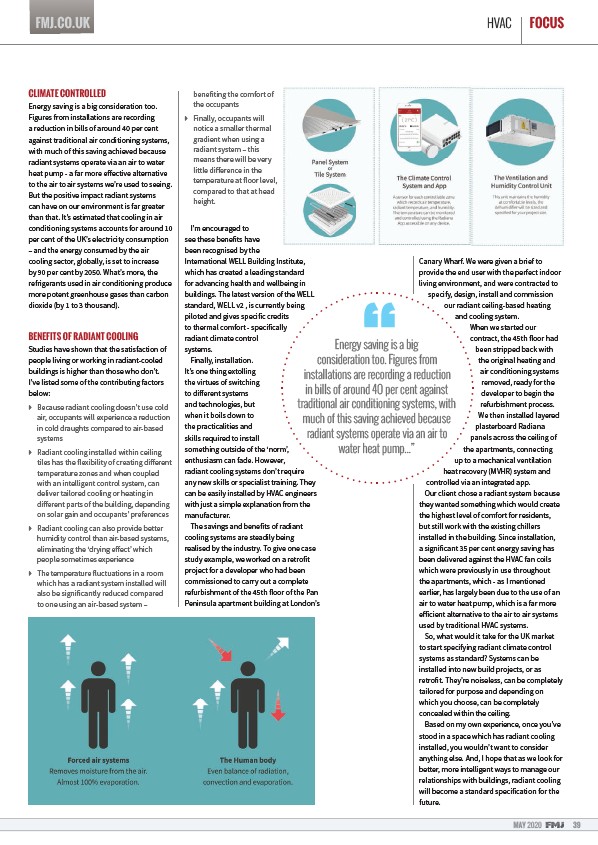
FMJ.CO.UK HVAC FOCUS
MAY 2020 39
CLIMATE CONTROLLED
Energy saving is a big consideration too.
Figures from installations are recording
a reduction in bills of around 40 per cent
against traditional air conditioning systems,
with much of this saving achieved because
radiant systems operate via an air to water
heat pump - a far more e ective alternative
to the air to air systems we’re used to seeing.
But the positive impact radiant systems
can have on our environment is far greater
than that. It’s estimated that cooling in air
conditioning systems accounts for around 10
per cent of the UK’s electricity consumption
– and the energy consumed by the air
cooling sector, globally, is set to increase
by 90 per cent by 2050. What’s more, the
refrigerants used in air conditioning produce
more potent greenhouse gases than carbon
dioxide (by 1 to 3 thousand).
BENEFITS OF RADIANT COOLING
Studies have shown that the satisfaction of
people living or working in radiant-cooled
buildings is higher than those who don’t.
I’ve listed some of the contributing factors
below:
Because radiant cooling doesn’t use cold
air, occupants will experience a reduction
in cold draughts compared to air-based
systems
Radiant cooling installed within ceiling
tiles has the flexibility of creating di erent
temperature zones and when coupled
with an intelligent control system, can
deliver tailored cooling or heating in
di erent parts of the building, depending
on solar gain and occupants’ preferences
Radiant cooling can also provide better
humidity control than air-based systems,
eliminating the ‘drying e ect’ which
people sometimes experience
The temperature fluctuations in a room
which has a radiant system installed will
also be significantly reduced compared
to one using an air-based system –
benefiting the comfort of
the occupants
Finally, occupants will
notice a smaller thermal
gradient when using a
radiant system – this
means there will be very
little di erence in the
temperature at floor level,
compared to that at head
height.
I’m encouraged to
see these benefits have
been recognised by the
International WELL Building Institute,
which has created a leading standard
for advancing health and wellbeing in
buildings. The latest version of the WELL
standard, WELL v2 , is currently being
piloted and gives specific credits
to thermal comfort - specifically
radiant climate control
systems.
Finally, installation.
It’s one thing extolling
the virtues of switching
to di erent systems
and technologies, but
when it boils down to
the practicalities and
skills required to install
something outside of the ‘norm’,
enthusiasm can fade. However,
radiant cooling systems don’t require
any new skills or specialist training. They
can be easily installed by HVAC engineers
with just a simple explanation from the
manufacturer.
The savings and benefits of radiant
cooling systems are steadily being
realised by the industry. To give one case
study example, we worked on a retrofit
project for a developer who had been
commissioned to carry out a complete
refurbishment of the 45th floor of the Pan
Peninsula apartment building at London’s
Canary Wharf. We were given a brief to
provide the end user with the perfect indoor
living environment, and were contracted to
specify, design, install and commission
our radiant ceiling-based heating
and cooling system.
When we started our
contract, the 45th floor had
been stripped back with
the original heating and
consideration too. Figures from
installations are recording a reduction
in bills of around 40 per cent against
traditional air conditioning systems, with
much of this saving achieved because
radiant systems operate via an air to
air conditioning systems
removed, ready for the
developer to begin the
refurbishment process.
We then installed layered
plasterboard Radiana
panels across the ceiling of
the apartments, connecting
up to a mechanical ventilation
heat recovery (MVHR) system and
Energy saving is a big
controlled via an integrated app.
Our client chose a radiant system because
they wanted something which would create
the highest level of comfort for residents,
but still work with the existing chillers
installed in the building. Since installation,
a significant 35 per cent energy saving has
been delivered against the HVAC fan coils
which were previously in use throughout
the apartments, which - as I mentioned
earlier, has largely been due to the use of an
air to water heat pump, which is a far more
e icient alternative to the air to air systems
used by traditional HVAC systems.
So, what would it take for the UK market
to start specifying radiant climate control
systems as standard? Systems can be
installed into new build projects, or as
retrofit. They’re noiseless, can be completely
tailored for purpose and depending on
which you choose, can be completely
concealed within the ceiling.
Based on my own experience, once you’ve
stood in a space which has radiant cooling
installed, you wouldn’t want to consider
anything else. And, I hope that as we look for
better, more intelligent ways to manage our
relationships with buildings, radiant cooling
will become a standard specification for the
future.
water heat pump...”